- Army
- Air Defense Systems
- Anti-tank systems and vehicles
- Armored Vehicles
- Armoured personnel carriers
- Artillery Vehicles and Weapons
- Command Post
- Communication Vehicles and Systems
- Electronic Warfare
- Engineer | Maintenance Vehicles
- Infantry Fighting Vehicles
- Main Battle Tanks
- Missiles
- Tactical and Logistic Vehicles
- Radars
- Unmanned Systems
- Weapons
- Navy
- Air
Patriot PAC-3 MSE GEM-T
Patriot PAC-3 - MSE - GEM-T
Long-range air defense missile system - United States
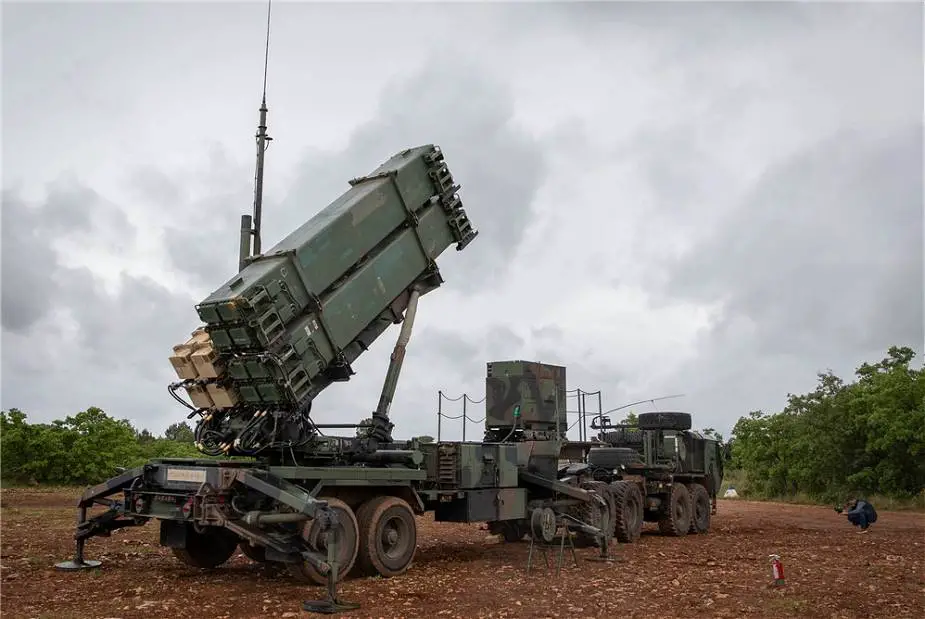
Description
The Patriot PAC-3, an advanced version of the Patriot air defense missile system, was developed by Raytheon, an American defense contractor. The PAC-3 system was designed to improve the capabilities of the original Patriot missile, with a focus on enhanced accuracy and effectiveness against ballistic missiles. This upgraded system entered into service in 2001, providing better protection and interception capabilities for its operators.
The Patriot Advanced Capability (PAC-3) missile will be integrated into the Patriot air defense system, offering protection against tactical ballistic missiles, advanced cruise missiles, and other airborne threats even in challenging environments with electronic countermeasures and uneven terrain.
The PAC-3 missile ensures total destruction of the target by directly hitting the incoming warhead, rather than relying on proximity detonation, which might only redirect or fragment the threat. This hit-to-kill capability is achieved by combining a highly precise seeker with an incredibly responsive airframe. Additionally, the missile uses a lethality enhancer to boost its performance against air-breathing threats. Each Patriot launcher holds 16 PAC-3 missiles, compared to the four PAC-2 missiles per launcher, and there are eight launchers in every Patriot battery.
Patriot PAC-3 variants:
- PAC-3 MSE: The PAC-3 Missile Segment Enhancement (PAC-3 MSE), fielded in 2015, represents the next generation PAC-3 missile and provides expanded battlespace performance against evolving threats. The PAC-3 MSE improves upon the original PAC-3 capability with a higher-performance solid rocket motor, modified lethality enhancer, more responsive control surfaces, upgraded guidance software, and insensitive munitions improvements.
- PAC-3 GEM-T: The GEM-T missile provides an improved ability to defeat tactical ballistic missiles, cruise missiles, or enemy aircraft in complement to the PAC-3 missile.
Technical Data
| Missile launcher unit |
|
The Patriot PAC-3 missile launcher unit is a key component of the Patriot air defense system, designed to effectively launch PAC-3 missiles against various aerial threats. The launcher is a mobile, semi-trailer-mounted platform that provides flexibility and maneuverability for the air defense system. Each launcher unit can carry up to 16 PAC-3 missiles in individual canisters, which is a significant increase compared to the four PAC-2 missiles per launcher.
The launcher unit is operated by a crew of trained personnel who handle the loading, unloading, and launching of the missiles. The unit is connected to the overall Patriot air defense system, including the radar and the engagement control station, which provide target detection, identification, and tracking information. The launcher's advanced communication and data-sharing capabilities allow it to receive real-time updates on the target's position, ensuring a high level of accuracy and effectiveness during engagements. |
| Missiles |
|
The PAC-3 Missile also named MIM-104F features a solid propellant rocket motor provided by Aerojet Rocketdyne, along with 180 small attitude control motors also supplied by Aerojet Rocketdyne. It is equipped with a Boeing Ka-band millimeter wave active radar seeker for targeting, as well as aerodynamic controls for maneuvering. Additionally, the missile utilizes an inertial guidance system (INS) for navigation purposes. The "F" designation denotes the PAC-3 Missile Segment Enhancement (MSE) version, an upgrade that provides significant improvements in terms of range, accuracy, and performance. The MIM-104F Patriot missile has a maximum range of approximately 160 km (99 miles) and can engage targets at altitudes of up to 24 km (15 miles).
The PAC-3 MSE features a larger, more powerful solid rocket motor, improved aerodynamic controls, and an upgraded guidance system. These enhancements enable the missile to better counter advanced threats, such as tactical ballistic missiles, cruise missiles, and even some low-flying satellites. The PAC-3 MSE (Missile Segment Enhancement) missile has a maximum range of approximately 35 km (22 miles) and can engage targets at altitudes of up to 15 km (9.3 miles). |
| Mobility |
| The M901 Launching Station, capable of carrying up to sixteen PAC-3 missiles, is responsible for transporting and launching the missiles. It is mounted on M860 semi-trailers and towed by the M983 HEMTT Patriot Tractor. The engagement control station (ECS) and Antenna Mast Group (AMG) are mounted on M927 5-Ton 6x6 cargo truck chassis. The Electric Power Plant (EPP III) is based on a 10-ton M977 HEMTT truck. The AN/MPQ-53 and AN/MPQ-65 radars are mounted on an M860 semi-trailer towed by an M983, heavy expanded mobility tactical truck (HEMTT). |
| Command and Control Vehicles |
| The combat element of the PATRIOT system is the fire unit, primarily consisting of a radar set (RS), AN/MSQ-104 Control Station engagement control station (ECS) and launching stations (LS). The RS provides airspace surveillance, target detection, discrimination, identification, classification, simultaneous tracking of targets, missile guidance and engagement support. The LS performs transport and missile launch functions and is remotely operated from the ECS, which provides command and control. The fundamental operating unit of a Patriot missile defense system is a battery or fire unit. Typically, it comprises a command post, radar, eight launchers, and support vehicles. These launchers can be placed up to 1 km away from the radar or command post vehicle. To ensure comprehensive and efficient defenses, batteries are spaced 30-40 km apart from each other. Reloading of the launchers with missiles is accomplished using a crane. At the core of the Patriot battery are the fire control section and associated launchers, which comprise several major end items. These include the Engagement Control Station (ECS) (AN/MSQ-104), Electric Power Plant (EPP III) (M977EPP), Radar Station (RS) AN/MPQ-53 or AN/MPQ-65, eight Launching Stations (LS) (M901), and Antenna Mast Group (AMG) (OE-349/MRC). Each end item serves a specific purpose and possesses distinct characteristics. The Engagement Control Station (ECS) serves as the operational control center for the Patriot Fire Unit (FU). It encompasses the Weapon Control Computer (WCC), man/machine interface, and various data and communication terminals. The ECS is designed to operate in both NBC and EMP environments, with air-conditioning and appropriate protection devices. The ECS shelter is weather-resistant and provides shielding from RFI, featuring suitable air inlet and exhaust ports for the environmental control systems. The left side, as viewed from the doorway, comprises three UHF RRT and a voice communication station, while the right side encompasses the very high frequency (VHF) DLT, radar weapon control interface unit (RWCIU), WCC, AN/VRC-92A SINCGARS radio, optical disc drives (ODD), and an embedded data recorder. |
 |
| Patriot Engagement Control Station (ECS) |
| During air defense (AD) operations, the ICC (Information and Coordination Central) serves as the command, control, and communication (C3) center for the Patriot Battalion. It is comprised of a lightweight, weather-resistant shelter mounted on a 5-ton cargo truck. The shelter provides protection against radio frequency interference (RFI) and electromagnetic pulse (EMP) radiation. It is equipped with two air conditioners mounted externally that provide heating, cooling, and ventilation to the interior. Additionally, an externally mounted gas particulate filter unit (GPFU) is used in situations involving nuclear, biological, or chemical (NBC) threats to provide clean air for the crew members. The ICC comprises two consoles that are manned by the Tactical Director (TD) and Tactical Director Assistant (TDA). An ICC status panel is positioned between the two consoles, displaying the status of all battalion fire units (FUs). |
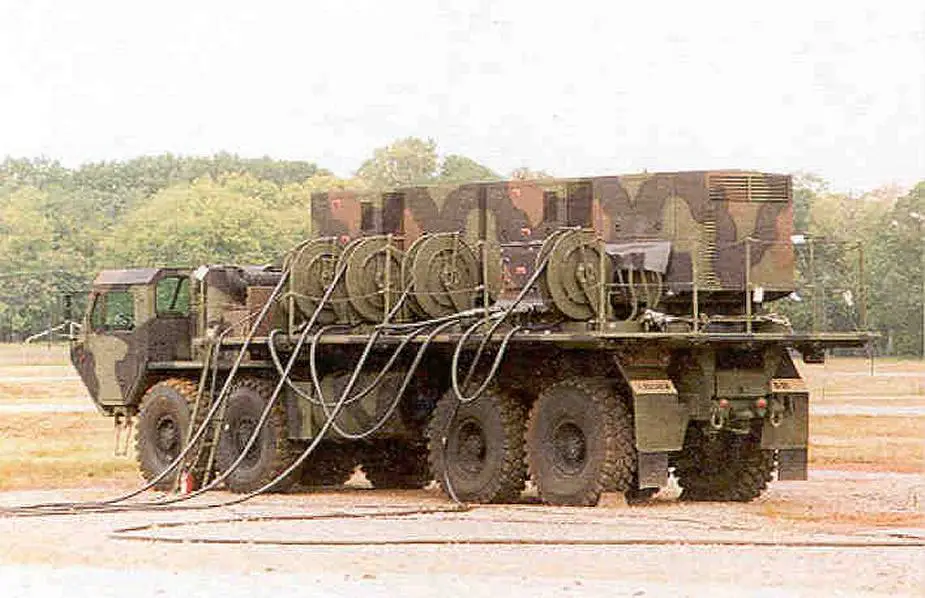 |
| Patriot Electric Power Plant (EPP III) is based on a 10-ton M977 HEMTT truck. |
| The primary power supply for both the ICC (Information and Coordination Central) and CRG (Communications Relay Group) is the EPU II, which is comprised of a 30 kW, 400 Hz generator mounted on a trailer that is towed by either the ICC or CRG. In order to provide sufficient power to both systems, two generators are designated for the ICC and two for the CRG. The Electric Power Plant (EPP III) is the primary source of power for both the ECS and RS. Each EPP comprises two 150 kW diesel engines that are linked through a power distribution unit (PDU) and installed on a 10-ton M977 HEMTT. Each EPP features two interlinked 75-gallon fuel tanks and a fuel distribution assembly equipped with grounding equipment. A single diesel engine can run for over eight hours when fully fueled. The CRG (Communications Relay Group) is responsible for providing a secure, bi-directional data relay system between the ICC, its assigned fire units, and neighboring units, utilizing multiple routes. Furthermore, the CRG offers both voice and data communication points for external elements that are not part of the Patriot system. |
 |
| Patriot Antenna Mast Group (AMG) |
| The Antenna Mast Group (AMG) is a mobile mast system that carries the amplifiers and antennas associated with the UHF communication equipment located in the ECS, ICC, and CRG. Two pairs of antennas, totaling four, are remotely controlled in azimuth and can be elevated to a maximum height of 100 feet, 11 inches above the ground. To deploy the AMG, it is first stabilized, and then the antenna feed is established, followed by the erection of the antennas using self-contained hydraulic and pneumatic systems. The antenna elevation is then adjusted. Cables for connection to the collocated shelter are carried on the AMG and include RF cables, control cables, and a prime power cable. |
 |
| Patriot AN/MPQ-53 radar |
| The AN/MPQ-53 or AN/MPQ-65 phased array radar is used for tracking and identifying targets, as well as guiding the PAC-3 missiles. It is mounted on a semi-trailer, allowing for easy transportation and setup. The AN/MPQ-53 Radar Station (RS) is composed of a multi-function phased array radar mounted on an M-860 semi-trailer that is towed by an M983 Heavy Expanded Mobility Tactical Truck (HEMTT). The ECS supervises and directs the radar and weapon control interface unit, which controls the RS. The RS performs several functions, such as very low- to very high-altitude surveillance, target detection, target classification, target identification, target tracking, missile tracking, missile guidance, and ECCM functions. The AN/MPQ-53 radar has a detection range of up to 100 km (62 miles) for aircraft and up to 100 km (62 miles) for tactical ballistic missiles. However, the actual range can vary depending on factors such as target altitude, radar cross-section (RCS), and environmental conditions. It can simultaneously track multiple targets, though its capacity is lower than the newer AN/MPQ-65 radar. It provides real-time information on target positions, speeds, and trajectories to the Patriot system's Engagement Control Station (ECS). |
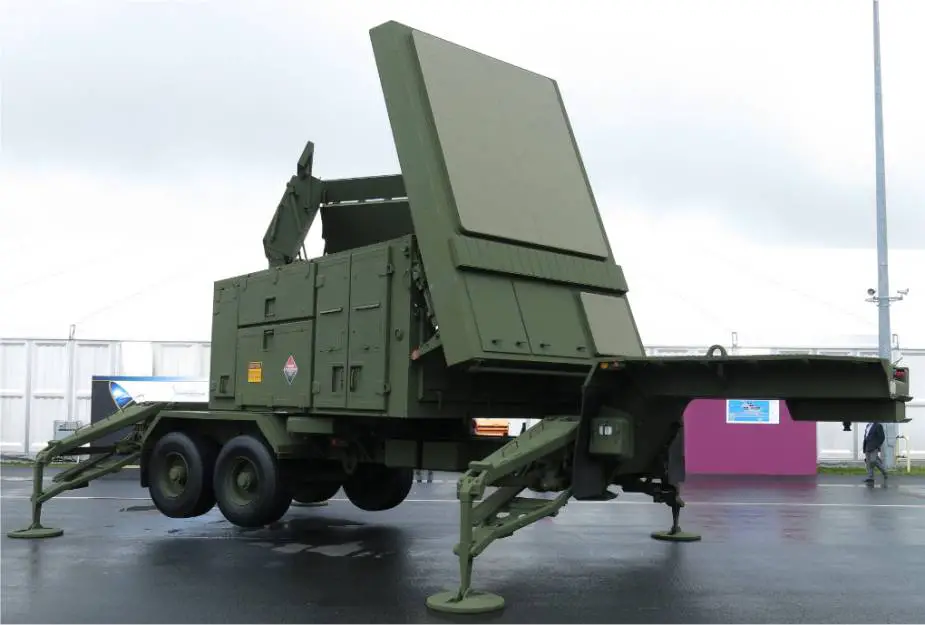 |
| Patriot AN/MPQ-65 (PAC-3) radar |
| The AN/MPQ-65 (PAC-3) is a passive electronically scanned phased array radar operating in the C-Band and mounted on M860 semi-trailers. As part of the Patriot PAC-3 program, the AN/MPQ-53 radar set has been replaced with the AN/MPQ-65. The upgraded AN/MPQ-65 radar set offers notable enhancements in expanded search capabilities, threat detection and identification, and engagement capability. The radar's search sector volume has been broadened, and the use of a second traveling wave tube has been incorporated. The radar system features a passive electronically scanned array (PESA) antenna, which allows for rapid beam steering and improved target tracking accuracy. The PESA antenna also provides increased resistance to electronic countermeasures (ECM) and jamming. The radar antenna is mounted at the front of the shelter and is erected to a fixed angle of 67.5° relative to the horizontal plane during deployment. The M-860 semi-trailer has built-in leveling equipment that enables deployment on slopes of up to 10°. The AN/MPQ-65 radar has a detection range of up to 100 km (62 miles) for aircraft and up to 160 km (99 miles) for ballistic missiles. However, the actual range can be influenced by factors such as altitude, radar cross-section (RCS) of the target, and environmental conditions. It can simultaneously track more than 100 targets, providing real-time information on target positions, speeds, and trajectories to the Patriot system's Engagement Control Station (ECS). The radar system can also detect and track tactical ballistic missiles, cruise missiles, and other low-observable (stealth) The AN/MPQ-65 radar operates in the C-band, specifically between 5.25 and 5.925 GHz. This frequency range provides a good balance between target detection range, resolution, and resistance to atmospheric attenuation. |
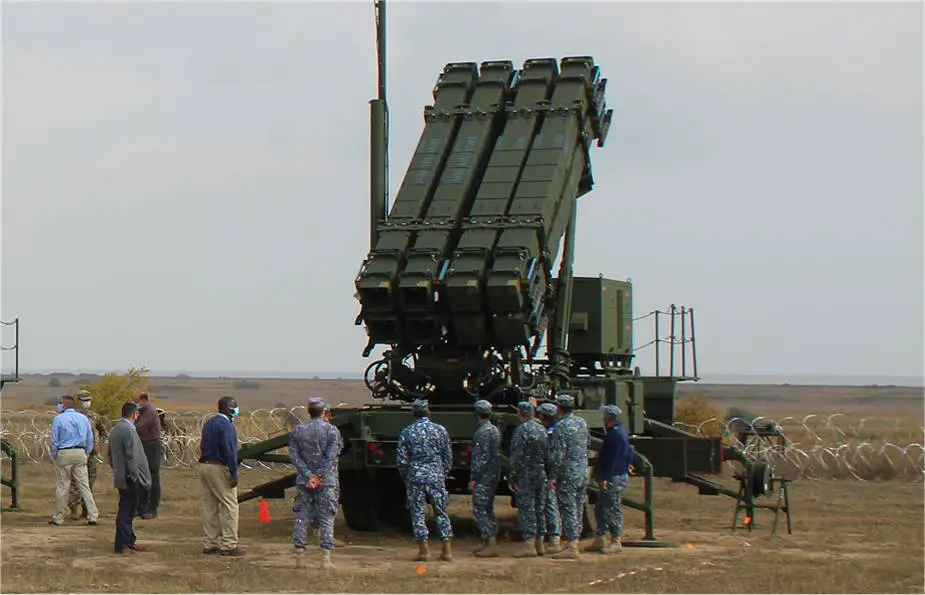 |
| The Patriot PAC-3 launcher unit can carry up to 16 surface-to-air missiles. |
| The Launching Station (LS) is a completely self-contained, remotely operated unit equipped with onboard power that can carry up to 16 PAC-3 missiles. The ECS controls LS operations using fiber optics or a VHF data link. The LS is mounted on an M-860 semi-trailer that is towed by an M983 HEMTT. The LS can be deployed on slopes of up to 10° thanks to leveling equipment. The LS can be trained in azimuth ±110° and elevated to a fixed launch position. Accurate emplacement and alignment of the LS before launch are crucial for engaging ballistic missiles. |
Specifications
| Armament | Weight Missile |
| Long-range, all-altitude, all-weather air defense missile system. | Launch weight of approximately 700 kg (1,540 lbs). |
| Country users | Length Missile |
| Germany, Israel, Japan, Kuwait, Netherlands, Poland, Qatar, Romania, South Korea, Sweden, Ukraine, United Arab Emirates, United States | Approximately 5.2 meters (17 feet) long. |
| Designer Country | Range Missile |
| United States | 20 to 35 km (12 to 22 miles) |
| Destruction capability | Guidance System |
| PAC-3 missile uses a hit-to-kill approach, which means it does not have an explosive warhead. Instead, it relies on the kinetic energy generated by the impact of the missile with its target to destroy it. The missile uses a solid rocket motor to propel itself towards the target. | Active radar seeker in the missile's nose, which allows it to track and engage targets autonomously. This guidance system is supplemented by mid-course updates from the ground-based radar and the missile's onboard inertial navigation system. |
| Speed Missile | Radar |
| Top speed of Mach 5, which is approximately 3,836 mph (6,173 km/h). | AN/MPQ-65 |
Details View
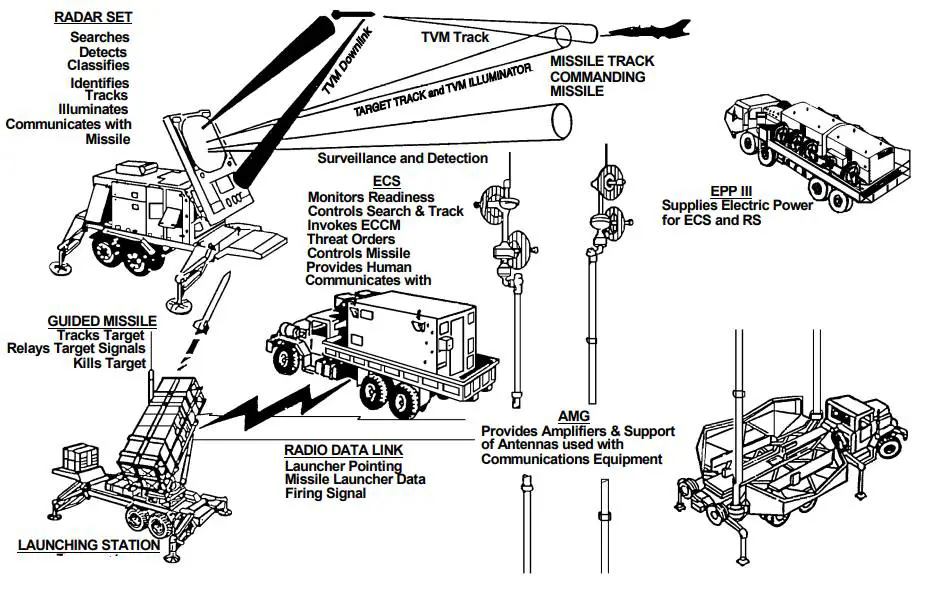 |
|
 |
Pictures - Video





























